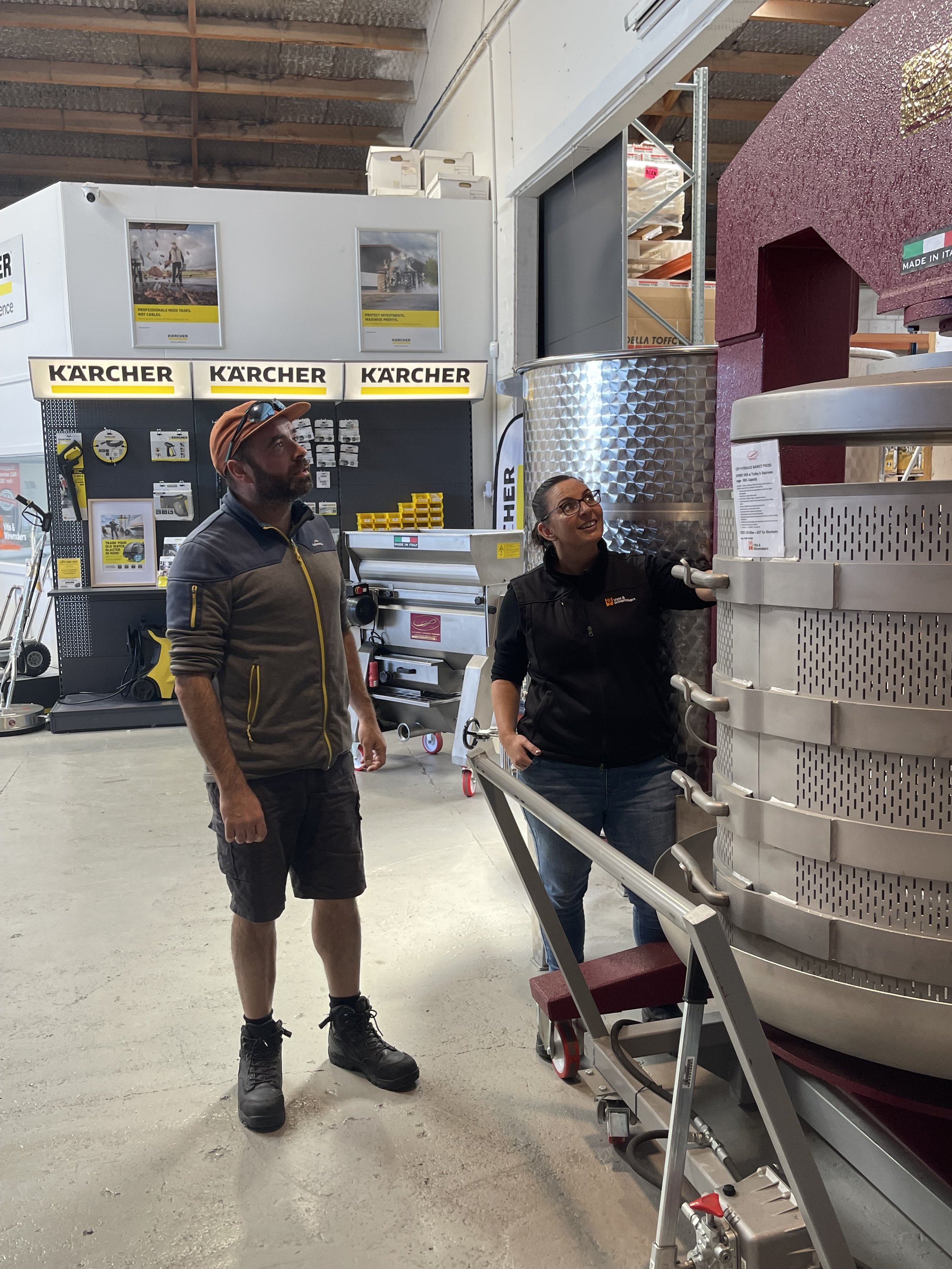Celebrating 30 Years Helping Winemakers
Vitis & Winemakers is celebrating 30 years in Marlborough. The Sun newspaper caught up with Managing Director Paul Baggio who described humble beginnings, a solid mission statement, changes in the New Zealand wine industry, technological advances, and the challenges posed by the last few years.
Kylie welcomes Eva of Eva Pemper Wines to the 30th celebration.
The early years
“Very humble beginnings indeed,” says Paul. “Some simple vats, plate and frame filters, the winemaking was often referred colloquially as bucket brewing.”
The beginnings were essentially a shed floor, all very agricultural of course and that was fine as most customers were of a traditional agricultural background and were exploring vineyards as a hobby.
“The range of winemaking equipment and harvest essentials were primarily made up of fermentation vats, variable capacity tanks, and some rudimentary pumps.
The mission statement
“30 years ago the business was small and the ‘mission’ was driven around the passion for the fledgling industry, a vision as to how things should build and grow, and that our customers should be treated and served as we would want to be served.
“It set the benchmark as to a ‘customer first’ mantra.”
In 2002/2003 a more formal doctrine of ‘customer first’ was drafted. To this day the language driving our organisation’s overall mission statement fundamentally remains as it has always been, ‘customer first’.”
The Vitis & Winemakers showroom with high quality range of tanks, presses, filters and much more
Changes in the industry
“Through much of the 90’s the winemaking remained very simple and industry hacks would openly refer to the ‘bucket brew’. The 2000’s saw the scaling of effective batch brewing with winemakers. The more modern vinification was born of necessity, and it saw a shift from focusing on batch winemaking to understanding the rapid movement and separation of juice from oxidisable enzymes. This offered much value, being able to make millions of litres of sauvignon blanc and other aromatic white wines. We worked with many local winemakers in those early years.
Particularly in Marlborough the number of Della Toffola presses, through to high solids cross flow filters dominate the industry landscape. Much is attributed to the relationships Vitis & Winemakers has built over the years.”
The team at Vitis & Winemakers Marlborough, from left: Wayne Le Cren, a 12 harvest veteran both in New Zealand and Australia, managing director Paul Baggio, sales and admin manager Kylie Potts, who has been part of the team since 2007 and brings a wealth of wine industry knowledge, and admin support Teena Jacques. Our local team’s product and technical expertise has grown from strength to strength over the last few years and we provide on-the-ground service support that’s second to none.
Technological advances
“The adoption of central membrane press technology is fundamental. It enabled long run, continuous juice extraction processing to occur. The reduction of browning fractions enabled a more fruit driven cleaner style of sauvignon blanc to emanate. The extensive plantings required a continuous flow of operation to be designed.
The continuous juice extraction solutions were extensively adopted so the significant flows of juice volumes then demanded high speed, lower cost solutions for juice clarification.
“With energy costs starting to climb, solutions such as ambient clarification at high speed were provided. Some of the largest non-refrigerant high speed clarification systems in the world have been installed into Marlborough. Similarly the collaborative approach to winery design and process flow led to some of the world’s most innovative wine cold stability technologies being installed. At a time when energy costs are soaring that technology proves to save significant costs on production.
“The challenges posed by sauvignon blanc’s notorious juice fibrous strands has plagued the local wine industry for many years. The work surrounding this has required strong collaboration.
In each of these instances, the industry faced challenges and being local, we were seeing this first hand. By understanding the region’s challenges we were able to provide leadership and forge the winemaking solutions in partnership with winemakers.”
The road ahead
“As some of the worst weather events in history ravage the North Island, climate change shows its very real influence to our wine and in particular viticulture industries. For those tendering vines the changes have been evident for some time, and the impacts to micro climates and growing regions stands as stark evidence to the generational issues that we all cannot ignore. That fact that Gisborne is fast becoming a significant growing region of sauvignon blanc must raise the eyebrows of many an industry veteran. The evolution of technological change will continue; it must. Technologies that tackle head on the soaring costs of energy will become common place.
The implications of any winery’s carbon footprint cannot be ignored. The language of carbon capture and seeking out more energy efficient processes are all front of mind. Providing solutions surrounding AI and automation is critical. Manufacturing through covid with the skilled labour shortages and challenges of broad supply chains, the coming years offer much opportunity to continue our strong solutions-driven partnerships with the local wine industry.
But all this said, the impact to the industry for the next years, be them 10, 20 or 30 years, will be the issues surrounding corporate governance, the imposition of local government, and water and waste management that most concern and require more than ever strong industry engagement and collaboration.”




